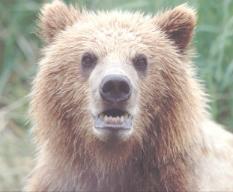
A run-of-the-mill dog's sense of smell is roughly 100 times greater than a human's. A good hound dog's nose is perhaps 300 times better.
Dr. George Stevenson, a former neurosurgeon who specializes in bear physiology, has found that a bear's scent system is at least seven times better than the hounds. “A polar bear will walk 100 miles in a straight line to reach a female ready to breed,” he said. “That's what the bear's nose can do. They smell a million times better than we do.”
When humans think about their hometowns, they think in terms of visual maps - down this street to that avenue, turn left at the bank, right at the stoplight. But bears don't see things that way. To get to their favorite huckleberry patch, they don't follow the trail to the tree with the broken limb, and then turn left at the big mossy rock.
“No, they have an olfactory map.” Take the scent of the trail to the smell of the anthill, then follow the smell of water to the perfume of huckleberries. It is difficult, Stevenson said, for humans to imagine such a way of knowing, but for bears it's essential.
Each spring, when they emerge from the den, they are literally starving. There's no time to wander around and look for food, to look for tracks in the snow and to follow them, perhaps, to a protein meal. “They have to smell food over huge distances, and then go straight to it,” Stevenson said. “If they can't, they die.”

The black pad on the bear's snout, like a dog's nose, is wired with hundreds upon hundreds of tiny muscles. Bears can manipulate their nostrils the way dexterous people control their nimble fingers.
The smells then travel up the two 9-inch snout channels, with hundreds of times the surface area of a human's nose, to a spot where 10 million nerve strands and a billion receptor cells fire electrical signals directly into the brain. The large hippocampus in the bear’s brain “remembers” the scent, adding it to the mental map that the bear uses to “see” the world.
Stevenson was a neurosurgeon from 1965 until 1993, a pioneer of micro-neuro surgery. These days, he lives near Yellowstone National Park and is affiliated with the University of Wyoming.
Excerpts from an article of the ‘Missoulian’ by MICHAEL JAMISON
